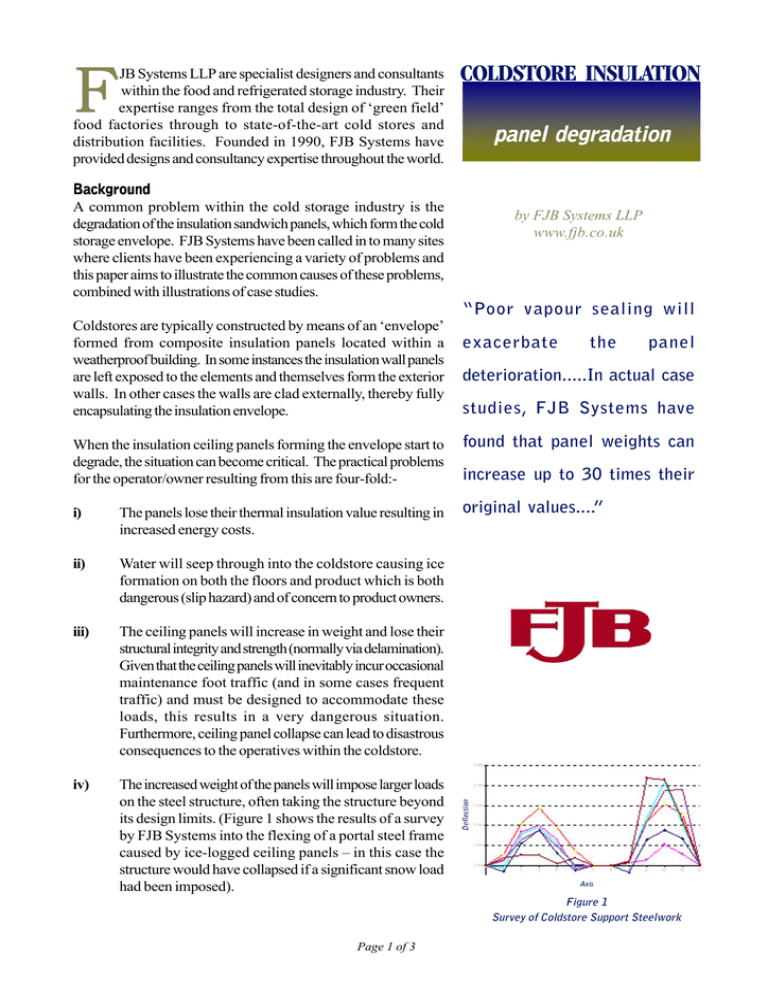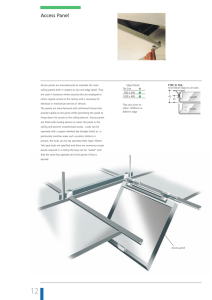Coldstore Insulation Panel Deterioration
advertisement

F JB Systems LLP are specialist designers and consultants within the food and refrigerated storage industry. Their expertise ranges from the total design of ‘green field’ food factories through to state-of-the-art cold stores and distribution facilities. Founded in 1990, FJB Systems have provided designs and consultancy expertise throughout the world. COLDSTORE INSULATION panel degradation Background A common problem within the cold storage industry is the degradation of the insulation sandwich panels, which form the cold storage envelope. FJB Systems have been called in to many sites where clients have been experiencing a variety of problems and this paper aims to illustrate the common causes of these problems, combined with illustrations of case studies. by FJB Systems LLP www.fjb.co.uk “Poor vapour sealing will Coldstores are typically constructed by means of an ‘envelope’ formed from composite insulation panels located within a weatherproof building. In some instances the insulation wall panels are left exposed to the elements and themselves form the exterior walls. In other cases the walls are clad externally, thereby fully encapsulating the insulation envelope. exacerbate the panel deterioration.....In actual case studies, FJB Systems have When the insulation ceiling panels forming the envelope start to degrade, the situation can become critical. The practical problems for the operator/owner resulting from this are four-fold:- found that panel weights can i) The panels lose their thermal insulation value resulting in increased energy costs. original values....” ii) Water will seep through into the coldstore causing ice formation on both the floors and product which is both dangerous (slip hazard) and of concern to product owners. iii) The ceiling panels will increase in weight and lose their structural integrity and strength (normally via delamination). Given that the ceiling panels will inevitably incur occasional maintenance foot traffic (and in some cases frequent traffic) and must be designed to accommodate these loads, this results in a very dangerous situation. Furthermore, ceiling panel collapse can lead to disastrous consequences to the operatives within the coldstore. iv) The increased weight of the panels will impose larger loads on the steel structure, often taking the structure beyond its design limits. (Figure 1 shows the results of a survey by FJB Systems into the flexing of a portal steel frame caused by ice-logged ceiling panels – in this case the structure would have collapsed if a significant snow load had been imposed). Deflection increase up to 30 times their Axis Figure 1 Survey of Coldstore Support Steelwork Page 1 of 3 Principal Causes There are a variety of possible causes of these problems. Sometimes there is one over-riding factor and other times a combination of factors contribute. The following outlines the six principal causes:(i) Inadequate Ventilation:- In certain climates (the UK is one such example), winter conditions can result in very high relative humidities within the cold store roof void above and to the side of the insulated envelopes. If the building is not properly designed and ventilated, this will lead to problems of condensation within the void and the resultant standing water will eventually penetrate the vapour seal of the composite panels and ingress the insulant. This situation is exacerbated due to there typically being no natural heat sources within a coldstore roof void and more normally the only services are refrigeration services which exacerbate the problem. Where coldstores panels are totally clad externally, lack of ventilation can lead to excessive condensation on the exterior of the walls and this sweating can often build up as ice within the wall voids. (ii) Inadequate Roof Insulation:- Single skin uninsulated roofing can cause problems during winter. When overnight temperatures fall below freezing, water moisture freezes to the underside of the sheeting. When ambient conditions warm, this ice thaws and the roof literally ‘rains’ onto the insulation panels. (iii) Roof Leaks:- Although seemingly obvious, unchecked roof leaks or overflowing gutters can be the sole cause of these problems. (iv) (v) Refrigeration Pipework:- The refrigeration services running through the voids can be a major cause of such problems. Typically the pipework insulation is too thin for the environment causing condensation to form during winter conditions. Additionally, poor vapour sealing leads to a rapid breakdown of the pipework insulation and the problem compounds. If the refrigeration system used is of the Low Pressure Receiver variety (LPR) then the continual cycling of hot gas through the liquid and suction lines will cause a cyclical pipework defrost and further water onto the panels. Refrigeration Valve Stations:- Poorly designed valve stations will lead to ice melting onto the ceiling panels. Page 2 of 3 COLDSTORE INSULATION panel degradation “By taking this approach, the owner/operator of a large store can save many hundreds of thousands of pounds by only replacing the damaged panels.” Core Sampling an ‘ice-logged’ panel Core Sampling a ‘dry’ panel (vi) Poor Vapour Sealing:- Poor panel vapour sealing will cause panel deterioration as well as accelerating it. Most insulation panel installers will not provide a long lasting vapour seal as standard and surprisingly most are unaware of how to effect one. These need to be properly specified. Effects & Solutions In actual case studies, FJB Systems have found that panel weights can increase up to 30 times their original values just by virtue of prolonged exposure to these adverse elements. In situations like these, even curing the causes of the problems will not be sufficient to rectify the situation and the panels will need to be replaced. The first approach is therefore to identify the scale of the problem and the causes. Both must be rectified if a long lasting solution is to be achieved. FJB Systems have found that correctly carried out thermographic surveys combined with core sampling can provide accurate predictions of which areas of insulation require renewal and which areas can remain. By taking this approach, the owner/operator of a large store can save many hundreds of thousands of pounds by only replacing the damaged panels. Figure 2 shows the results of a particular store surveyed by FJB Systems and which illustrates the areas requiring replacement (approximately 30% of the total ceiling area). Prior to contacting FJB Systems, the Client had been provided with numerous quotations from Insulation Contractors recommending that the whole ceiling be replaced. panel degradation “...correctly carried thermographic out surveys combined with core sampling can provide accurate predictions of which areas of insulation require renewal....” A waterlogged roof void 1 2 3 4 5 6 7 8 9 The other key factor determining the best solution is whether the store is required to remain operational during the repairs. In most cases this will definitely be the case as few operators can afford to close down their businesses. In such cases, areas of coldstore will need to be cordoned off and panel repairs will effectively be carried out under sub-zero conditions. This can be both time consuming and costly, and in order to undertake such work effectively and economically, FJB Systems would typically write a detailed specification of how the works are to be effected and put this out to competitive tender. COLDSTORE INSULATION 10 11 13 14 15 16 17 18 19 20 21 22 S18 S17 Figure 2 Thermographic Survey Results S16 S15 S14 S13 S12 S11 S10 S9 S8 S7 S6 S5 S4 S3 S2 S1 Page 3 of 3 12 Conclusions FJB Systems have found that insulation panel deterioration is a frequent event and caused primarily through poor total design of the coldstores – this relates to the refrigeration services, the building design as well as the panel vapour sealing and construction details. In many cases the causes of the problem can be subsequently ‘designed out’ and if caught soon enough, the situation will not have deteriorated enough to warrant complete panel replacement. This is not always the case and the worst cases encountered have shown that the ceiling panels are both unstable (hence unsafe) and that the steel structures are overloaded to the point of collapse.


